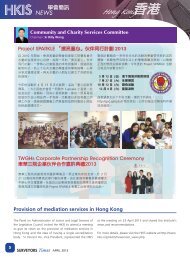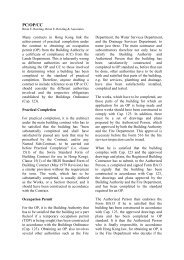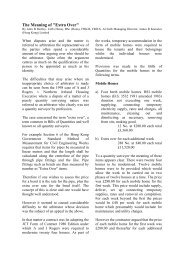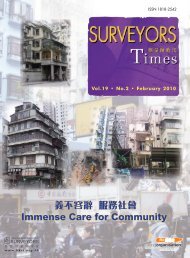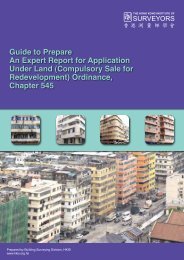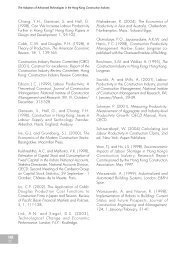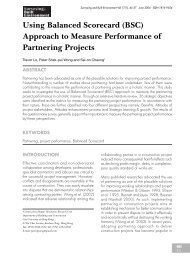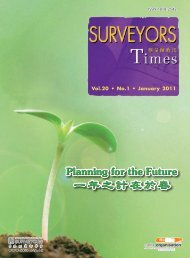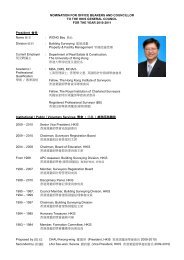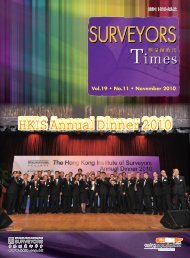Surveying & Built Environment Vol. 22 Issue 1 (December 2012)
Surveying & Built Environment Vol. 22 Issue 1 (December 2012)
Surveying & Built Environment Vol. 22 Issue 1 (December 2012)
You also want an ePaper? Increase the reach of your titles
YUMPU automatically turns print PDFs into web optimized ePapers that Google loves.
SBE<br />
32<br />
Reconstructing The Early History of the Gin Drinker’s Line from Archival Sources<br />
Except PB 414 and 419, the layout of<br />
other pillboxes closely resembled the<br />
design stipulated in the Manual of Field<br />
Engineering of the Royal Engineers<br />
(RE), issued in 1936 44 . Most of them<br />
had a width of 5.5-6m and a length<br />
of 2.5-4m and had two embrasures,<br />
such as those found at the Shing Mun<br />
Redoubt. Lawrence Lai et al. had<br />
conducted detailed research on these<br />
more standardised pillboxes, 45 with the<br />
only difference being the absence of<br />
the concrete wall within the pillboxes.<br />
As the previous RE Manual was issued<br />
in 1925, the two pillboxes illustrated<br />
above were probably “experimental<br />
pieces”. Currently, there is only<br />
circumstantial evidence to prove that<br />
they were the first British pillboxes<br />
built across the British Empire during<br />
the Interwar Period, but they certainly<br />
predated the pillboxes built on the<br />
British Isles in 1940. 46 Further research<br />
is required to discern the ways in<br />
which the Hong Kong pillboxes did<br />
or did not influence the design of their<br />
counterparts at home, or were linked<br />
to late WW1 designs, or designs being<br />
used in contemporary British India.<br />
The Changing Purpose of the Line<br />
The planned use of the Line changed<br />
over time. In the Defence Scheme<br />
of 1936, General Bartholomew saw<br />
the Line as the final position of the<br />
mainland garrison:<br />
In the event of the enemy<br />
achieving considerable successes<br />
north and west or east of<br />
the “Inner Line” – by sheer<br />
weight of numbers or by the<br />
synchronization of his thrusts –<br />
it is the Fortress Commander’s<br />
intention to delay the enemy<br />
from every direction and finally<br />
to fight the issue out to a finish<br />
in the “Inner Line”<br />
…even the smallest of foremost<br />
defended localities must fight<br />
out to the last man and the last<br />
round...troops (will be) fighting<br />
their way back steadily to the<br />
“line of the Passes,” where the<br />
final issue will be fought out to a<br />
finish. 47<br />
Throughout the Defence Scheme,<br />
Bartholomew made no provision for the<br />
withdrawal of troops from the mainland<br />
to Hong Kong Island. The Kowloon<br />
garrison was expected to be destroyed<br />
in the attempt to impose maximum<br />
delay on the advancing enemy in order<br />
to prevent the capture of the Island.<br />
As he had deployed three out of four<br />
battalions of the garrison to Kowloon,<br />
Bartholomew was seemingly confident<br />
that the Line would enable the garrison<br />
to resist until reinforcement arrived.<br />
Nonetheless, sources suggested that he<br />
was less sanguine about the possibility<br />
of holding Hong Kong with the existing<br />
garrison. When he was replaced by<br />
Major General Arthur Grasett in 1938,<br />
he urged the War Office to deploy at<br />
least eight battalions in order to allow<br />
44<br />
War Office, Manual of Field Engineering, 2 vols., London: HMSO, 1933-36. <strong>Vol</strong>. 1, All Arms; <strong>Vol</strong>.2,<br />
Royal Engineers, the design is in vol.2.<br />
45<br />
Lai LWC (2009), 16-41.<br />
46<br />
Lowry B, The Gin Drinker’s Line: Its Place in the History of Twentieth Century Fortification, 61-62.<br />
47<br />
Hong Kong Defence Scheme (1936), Hong Kong Public Records Office, 343.01 HON, 58-59, 63.



